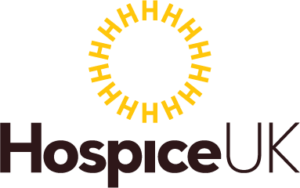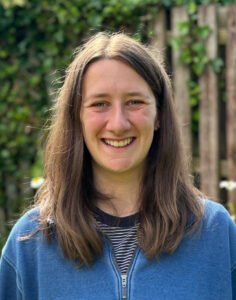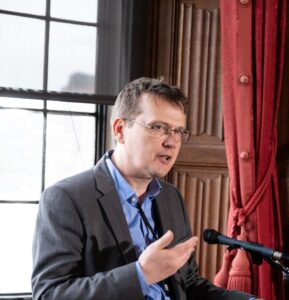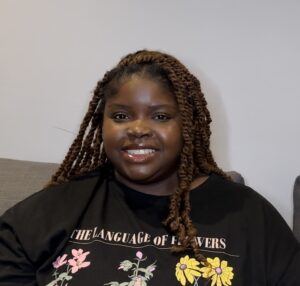Looking for more charity digital transformation inspiration? Read the stories of how organisations have made hard won progress with charity digital transformation this year. If you’d like to share a case study of your charity digital transformation, please email us with more information on zoe@zoeamar.com.


Freya Mumford, Digital Manager, EY Foundation
This year we’ve started to look closely at not just how we can use digital solutions to enhance our employability skills training for young people from low-income backgrounds, but to also consider what impact the advancement of technologies like VR and Gen AI will have on the future of work. We want to do everything we can to make sure the skills we’re training young people in are future proof, to ensure they are well placed to thrive in fast evolving workplaces across sectors.
To do this we have researched how rapidly emerging technologies can be developed in the most inclusive way, as well as how we prepare our young people to use them effectively, understanding the pitfalls as much as the opportunities. From February 2024 we introduced new Gen AI training across our flagship employability skills training programmes, giving hundreds of young people access to a bespoke Gen AI platform alongside training on effective use.
We also trialled several ways of using emerging technology to deliver our work. We ran the first ever charity event in a custom-built digital twin of our office, inviting charities from across the UK to understand what new technologies could mean for them. We then used this metaverse-style environment in our training with young people, bringing a case study challenge to life in a virtual office.
Moving forward we’re continuing to build on these foundations. Connectivity, navigating digital poverty and keeping up to date with the relentless advancements in tech are priority considerations for our continued testing of where technology can add the most value to our work. Central to our approach and progress so far has been listening to the views of young people, learning from experts, and not being afraid to try something new.


Steve Thorlby-Coy, Director of IT and Digital Services, Hospice UK
I’ve used the Charity Digital Skills Report as a reference point since re-joining the charity sector in 2022. It helped provide clarity and focus as I planned the Hospice UK improvement programme. I was able to use the report to consider some of the organisational barriers and risks we might encounter, such as funding and skills, as well as technical challenges such as security and useability.
Having persuaded the Board and Senior Leadership Team to invest, our main focus over the last year has been on implementation. We needed to establish modern, secure and stable foundations to build on in the future. So, whilst it may not be particularly innovative, we have worked at pace to upgrade our business systems (CRM, Finance, HR/Pay, Grant Management) as well as implementing Microsoft 365. We decided to move fully to the cloud and so a significant milestone was decommissioning our legacy server infrastructure towards the end of our programme.
I’m proud of my small in-house team, which worked relentlessly with the support of a willing and capable supplier network to deliver a significant change every month for the last 18 months. This has reduced our security and technical risks, but introduced new ones. Changing everything quickly, is ambitious but achievable. We found that with the right suppliers, the technology is relatively straightforward to implement, though we deliberately chose widely available tried and tested products and services.
People really do make or break digital projects. Engaging in training and testing is challenging to manage alongside ‘the day job’. Colleagues have been willing, but we know we need to continue to commit time to ensuring new systems and ways of working are adopted well.


Beth Hobbs, Communications Coordinator, SHASBAH
Over the last year, we have tweaked our communications strategy in a way that has had significant implications for the way we use our digital platforms. After attending a course run by Digital Charity Lab, we decided to start using an email marketing platform. Email marketing became our main avenue for communicating information with our charity’s members and beneficiaries. Previously, we had been using social media platforms such as Facebook and Instagram as ‘bulletin boards’, with all news and upcoming events being posted there. However, this information only reached a fraction of our membership because many of them don’t use social media and because the algorithm controls which posts a user is shown.
We uploaded our mailing list of 160 existing subscribers and created pathways for gathering new leads, such as event booking forms and website pop-ups. We have since gained over 30 new subscribers, which is an increase of 19% over 6 months.
Now, we are free to use social media as an outreach tool. We have been experimenting with different types and different genres of post, e.g. text posts, entertainment posts, educational posts, sharing blogs and resources. Using analytics, we are building up a picture of which posts get the most reach and engagement, which we measure via shares, likes and comments.
The migration to email marketing software required time up front in learning how to use the software and inputting our existing data. We also had to navigate changes from Gmail in how they identify spam emails. We have learnt to segment our mailing list into categories to make the emails we send more relevant to the audience. We have also learnt to use our email software to send out surveys after events, in order to help us gather feedback and evidence for our services.


Russell Findlay, CEO, Speakers Trust
Speakers Trust has been leveraging no-code tools like Airtable and Zapier for 5 years to communicate with stakeholders, automate processes, and connect data. This has enabled our team of ten to support nearly 40,000 beneficiaries across over 700 schools, doubling our reach without significantly growing the team.
While the past 5 years focused on using technology to increase reach without increasing cost, this year we shifted to using technology to enhance our data for better impact management and to improve the beneficiary and funder experience. The biggest gamechanger has been combining AI and automation tools.
AI allows us to draw insights from feedback and impact data. Previously, impact reports were an annual chore, but now we can create real-time reports incorporating qualitative and quantitative data. I now look forward to daily emails that synthesise the previous day’s impact, providing a digestible perspective and up-to-date trends.
AI is also transforming how we deliver. Our biggest constraint to building young people’s communication skills is the availability of our expert coaches. Our new AI speaking coach can “watch” a speech and provide useful feedback on content, structure, and delivery. It won’t replace a coach, but has already proven valuable in building skills and confidence in young people, affordably.
Our journey has not been without challenges. Building a digitally confident cultire without an IT team required everyone to embrace a no-code approach to digital transformation. Balancing technology’s potential with the team’s capacity to manage change has been a learning process. Financial constraints in scaling solutions and the need for greater strategic support in areas like Digital Product Development, Privacy, and AI Ethics are ongoing challenges.
Despite these challenges, our major takeaway is that digital transformation shouldn’t be limited to larger charities. By identifying the most important role technology can play, small and medium-sized charities can broaden reach, increase impact, and transform how they achieve their objectives.


Harry Gray, Volunteer and Steering Group Member, Walk Ride
Walk Ride GM (WRGM) ) is a Greater Manchester-based group campaigning for safer and easier active travel, promoting walking, wheeling, and cycling for their health, community, and environmental benefits. We campaign by pressuring political leaders to deliver on their strategies whilst supporting and empowering actively engaged individuals in local communities.
A forum for conversations is crucial to our work, providing a space for supporters to share insights, seek support, and stay informed about regional happenings. We use the Discord platform, a voice, video, and text chat app popular among small, active communities for regular communication.
Discord has a lower barrier to posting and engaging compared to similar platforms like Slack. Users treat Discord as a social media platform rather than a workspace, encouraging more participation. Campaigning often blurs the line between work and hobby, and people appreciate a relaxed, informal setting for input.
Initially, getting users to sign up for Discord was challenging due to scepticism and fatigue surrounding new social media platforms. Our strategy involved engaging a core base of active users on other platforms and ensuring consistent content posting by core WRGM members. We widely publicised the sign-up link on our website, newsletter, and highly engaged social media posts. Eventually, the Discord gained enough active users to flourish without central group content pushing. Over the past year, we have grown the Discord to nearly 300 members.
The Discord features multiple channels on regional areas and campaign topics. Some users actively participate in only one or two channels representing their specific interests within active travel campaigning. Others find value in the content posted by others without necessarily posting themselves. An event section enables users to calendar upcoming in-person events, boosting attendance.
We view Discord as a tool to energise and upskill campaigners, empowering them to be more effective in their local communities and advocating for the big-picture policies we support.

Paulina Stachnik, Head of Communications, Women for Women International UK
Over the past year, we have significantly expanded our use of AI within our digital strategy. Our Marketing and Communications team has integrated AI into functions including content creation, data analysis, trend identification in social media comments and document summaries. The tool has also helped us standardise spellings between American and British English and streamline idea generation for strategy documents and funding applications. Additionally, AI has played a critical role in translating content and creating first drafts for complex externally facing questions based on our internal messaging.
One notable achievement is the implementation of the AI platform Dataro, which has supported our approach in building targeted email lists. This shift has improved our efficiency and accuracy in reaching our audience while reducing donor fatigue while maintaining a human touch. For example, we identified donors most likely to churn and sent them handwritten notes at the end of the year expressing our appreciation and highlighting the impact of their support, resulting in fewer cancellations in January 2024.
Throughout this journey, we encountered several barriers, primarily around apprehensions regarding AI adoption.
Despite initial concerns from some team members about the potential redundancy of their roles due to AI, we have successfully demonstrated AI as a complementary tool rather than a replacement. This has led to increased buy-in and a more positive outlook towards AI integration.
Addressing these concerns required transparent communication and continuous demonstration of AI’s benefits, particularly in saving time during busy periods. It was also important to highlight that as a charity, we need to use our resources—including time—efficiently to ensure the strongest impact for the women survivors of war we serve. Ensuring responsible use of AI tools, maintaining a balance between automation and human judgment, was also crucial.
From these experiences, we have learned the importance of gradual implementation and fostering an open-minded culture towards new tools. Moving forward, we are optimistic about further integrating AI to improve our efficiency and productivity, ultimately allowing us more time to focus more on strategic objectives.


Tony Ford, Neighbourhood Watch Coordinator, Sandiacre Friendship Hub
The Friendship Hub, once a humble pop-up Free Food Stall during lockdown, has transformed into a vibrant community centre. Operated by a dedicated Neighbourhood Watch Coordinator on Kings Road Sandiacre, the stall’s popularity soared, drawing people from far and wide. An invitation to use the local Methodist Hall during inclement weather marked the beginning of the Hub’s evolution, expanding to offer a café, food stall, community activities, and a Digital Inclusion Hub across two Church Halls on two days a week.
The Digital Inclusion initiative addressed the issue of people missing crucial information sent via email by various organisations. Despite daily briefings, the information shared only reached regular attendees. Grants were secured to provide computers, MiFi, and Hotspots, while donated devices and free SIM cards were distributed. However, older patrons remained hesitant to engage with technology.
To increase engagement, family history research, games, and exploration of relevant websites were introduced. ABC keyboard apps were downloaded to simplify the process for older users. Volunteers, including a young lady on a gap year, managed the initiative on Fridays, which became the main day for people to seek individual help with phones or apps.
Recently, a 70-inch screen was installed to facilitate email sharing and game demonstrations. Machines are now placed on every café table, and patrons work on A4 activity sheets with volunteer assistance. The aim is to measure progress and produce follow-up sheets as engagement grows. Skilled patrons also step up as temporary volunteers.
The Friendship Hub continues to seek new ideas and resources to support its mission of digital inclusion, finding fulfilment in every success story as it bridges the digital divide within the community.


Ozioma Nlewedum, Associate Product Manager, Scouts
Over the past year, we have significantly embraced digital transformation to enhance our volunteers’ experience. Recognising the importance of digital skills, particularly in relation to the upcoming launch of our new digital tools for volunteers, we launched and improved upon initiatives that encourage digital skills growth in our volunteers.
Our Digital Skills Tool is designed to help volunteers assess and enhance their digital confidence. This tool offers resources, empowering volunteers to use digital platforms effectively and support young people better. It includes a Digital Champions feature so that volunteers can request more in-depth help and ask questions to other volunteers who are more digitally confident. In addition, we’ve also been updating our Digital Ready Framework, giving our staff members the opportunity to upskill themselves in topics such as Data Fluency, Using AI and Digital Mindset.
Our new digital tools will be launched later this year, these include tools to manage volunteer membership, learning and joining. The tools put user experience at its centre, making it easier for volunteers to manage their profiles, access resources and learning, apply for permits and communicate with each other. As a major multi-year transformation project, it has come with challenges along the way. We’ve had particular challenges with how we migrate data from legacy systems. We’ve also needed to make infrastructure updates to improve integration of our systems. To underpin this development we have undergone cloud migration to make our systems more scalable and improve security. Throughout this journey, we’ve learnt the value of continuous feedback and iteration, we’ve involved a large group of volunteers with testing all the way through this project, and they have been vital to ensure that we are creating products which meet their needs. We’ve also had to be adaptable to find solutions, and rethink our approach when there have been roadblocks. By focusing on enhancing digital skills and modernising our digital tools, we have laid a strong foundation for continued innovation and growth in the future services.


Dorian Harris, Founder, Artiface
PetRehomer, a nationwide pet charity, depends on volunteers to carry out its essential work connecting pet owners with potential adopters. Yet, the transient nature of the volunteer workforce and the training required for some tasks was creating bottlenecks that affected the charity’s ability to scale effectively.
The AI solution began with a speculative discussion between Colleen Long, the founder of PetRehomer, and Dorian Harris, founder of AI consultancy, Artiface. Together, we identified potential tasks for AI by looking for workflows within PetRehomer that were both repetitive and hard to learn. The existing workflow for writing social media posts exactly fitted the description.
We conducted an initial test using ChatGPT to craft engaging social media content. ChatGPT performed well but would have required separate accounts for every volunteer so we sought a more integrated solution with the development of a custom interface using the NoCode platform, Bubble.io. This allowed all volunteers to access GPT-4 through a single interface, without needing individual OpenAI accounts, and opened up further possibilities for refinement, such as specific prompts for different pet types.
The AI tool dramatically reduced the time required to train volunteers by 50% and the time writing social media posts by 80%, from 25 minutes down to 5 minutes. The process of crafting pet descriptions became not only quicker but also more enjoyable, enhancing volunteer satisfaction and engagement.
The AI tool has fundamentally transformed PetRehomer’s operations, allowing the charity to process more pets daily and shift focus from managing operational bottlenecks to expanding outreach and support for pet owners in need of rehoming services.
